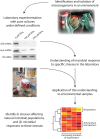Application of meta-transcriptomics and -proteomics to analysis of in situ physiological state
- PMID: 22783237
- PMCID: PMC3390588
- DOI: 10.3389/fmicb.2012.00184
Application of meta-transcriptomics and -proteomics to analysis of in situ physiological state
Abstract
Analysis of the growth-limiting factor or environmental stressors affecting microbes in situ is of fundamental importance but analytically difficult. Microbes can reduce in situ limiting nutrient concentrations to sub-micromolar levels, and contaminated ecosystems may contain multiple stressors. The patterns of gene or protein expression by microbes in nature can be used to infer growth limitations, because they are regulated in response to environmental conditions. Experimental studies under controlled conditions in the laboratory provide the physiological underpinnings for developing these physiological indicators. Although regulatory networks may differ among specific microbes, there are some broad principles that can be applied, related to limiting nutrient acquisition, resource allocation, and stress responses. As technologies for transcriptomics and proteomics mature, the capacity to apply these approaches to complex microbial communities will accelerate. Global proteomics has the particular advantage that it reflects expressed catalytic activities. Furthermore, the high mass accuracy of some proteomic approaches allows mapping back to specific microbial strains. For example, at the Rifle IFRC field site in Western Colorado, the physiological status of Fe(III)-reducing populations has been tracked over time. Members of a "subsurface clade" within the Geobacter predominated during carbon amendment to the subsurface environment. At the functional level, proteomic identifications produced inferences regarding (i) temporal changes in anabolism and catabolism of acetate, (ii) the onset of N(2) fixation when N became limiting, and (iii) expression of phosphate transporters during periods of intense growth. The application of these approaches in situ can lead to discovery of novel physiological adaptations.
Keywords: marine habitats; physiological indicators; subsurface sediments.
Figures


Similar articles
-
Transcriptome of Geobacter uraniireducens growing in uranium-contaminated subsurface sediments.ISME J. 2009 Feb;3(2):216-30. doi: 10.1038/ismej.2008.89. Epub 2008 Oct 9. ISME J. 2009. PMID: 18843300
-
Gene Expression Correlates with Process Rates Quantified for Sulfate- and Fe(III)-Reducing Bacteria in U(VI)-Contaminated Sediments.Front Microbiol. 2012 Aug 9;3:280. doi: 10.3389/fmicb.2012.00280. eCollection 2012. Front Microbiol. 2012. PMID: 22908009 Free PMC article.
-
Development of a biomarker for Geobacter activity and strain composition; proteogenomic analysis of the citrate synthase protein during bioremediation of U(VI).Microb Biotechnol. 2011 Jan;4(1):55-63. doi: 10.1111/j.1751-7915.2010.00194.x. Microb Biotechnol. 2011. PMID: 21255372 Free PMC article.
-
Proteomics to assess the role of phenotypic plasticity in aquatic organisms exposed to pollution and global warming.Integr Comp Biol. 2012 Nov;52(5):681-94. doi: 10.1093/icb/ics087. Epub 2012 May 28. Integr Comp Biol. 2012. PMID: 22641836 Review.
-
Geobacter: the microbe electric's physiology, ecology, and practical applications.Adv Microb Physiol. 2011;59:1-100. doi: 10.1016/B978-0-12-387661-4.00004-5. Adv Microb Physiol. 2011. PMID: 22114840 Review.
Cited by
-
Dynamics in microbial communities: unraveling mechanisms to identify principles.ISME J. 2015 Jul;9(7):1488-95. doi: 10.1038/ismej.2014.251. Epub 2014 Dec 19. ISME J. 2015. PMID: 25526370 Free PMC article.
-
Reflection on Molecular Approaches Influencing State-of-the-Art Bioremediation Design: Culturing to Microbial Community Fingerprinting to Omics.J Environ Eng (New York). 2016 Oct;142(10):10.1061/(ASCE)EE.1943-7870.0001141. doi: 10.1061/(ASCE)EE.1943-7870.0001141. Epub 2016 Aug 16. J Environ Eng (New York). 2016. PMID: 28348455 Free PMC article.
-
Diatom proteomics reveals unique acclimation strategies to mitigate Fe limitation.PLoS One. 2013 Oct 16;8(10):e75653. doi: 10.1371/journal.pone.0075653. eCollection 2013. PLoS One. 2013. PMID: 24146769 Free PMC article.
-
Characterizing Natural Organic Matter Transformations by Microbial Communities in Terrestrial Subsurface Ecosystems: A Critical Review of Analytical Techniques and Challenges.Front Microbiol. 2022 May 4;13:864895. doi: 10.3389/fmicb.2022.864895. eCollection 2022. Front Microbiol. 2022. PMID: 35602028 Free PMC article. Review.
-
Understanding and Designing the Strategies for the Microbe-Mediated Remediation of Environmental Contaminants Using Omics Approaches.Front Microbiol. 2018 Jun 4;9:1132. doi: 10.3389/fmicb.2018.01132. eCollection 2018. Front Microbiol. 2018. PMID: 29915565 Free PMC article. Review.
References
-
- Allgeier J. E., Rosemond A. D., Layman C. A. (2011). The frequency and magnitude of non-additive responses to multiple nutrient enrichment. J. Appl. Ecol. 48 96–101
-
- Alsaker K. V., Paredes C., Papoutsakis E. T. (2010). Metabolite stress and tolerance in the production of biofuels and chemicals: gene-expression-based systems analysis of butanol, butyrate, and acetate stresses in the anaerobe Clostridium acetobutylicum. Biotechnol. Bioeng. 105 1131–1147 - PubMed
-
- Anderson R. T., Vrionis H. A., Ortiz-Bernad I., Resch C. T., Long P. E., Davyault R., Karp K., Marutzky S., Metzler D. R., Peacock A., White D. C., Lowe M., Lovley D. R. (2003). Stimulating the in situ activity of Geobacter species to remove uranium from the groundwater of a uranium-contaminated aquifer. Appl. Environ. Microbiol. 69 5884–5891 - PMC - PubMed
-
- Anderson-Glenna M. J., Bakkestuen V., Clipson N. J. W. (2008). Spatial and temporal variability in epilithic biofilm bacterial communities along an upland river gradient. FEMS Microbiol. Ecol. 64 407–418 - PubMed
LinkOut - more resources
Full Text Sources
Research Materials

